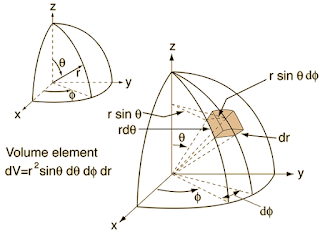Distance on the surface of a sphere
A common problem is how to measure distances on a sphere. For our normal, flat, Euclidean space, it is simply a straight line. However, this is not the case on the surface of a sphere. Do to it's curvature, the shortest path from one point to another (geodesic path) is a segment of a great circle. The derivation is short and can be found on WolframMathWorld | Great Circle. The distance is,
- With \(\lambda\)=longitude and \(\delta\) = latitude \[ d = R~\cos^{-1}\left[\cos{\delta_1}\cos{\delta_2}\cos{(\lambda_1-\lambda_2)}+\sin{\delta_1}\sin{\delta_2}\right], \] the angular change is \(d/R\).
- If you want to use pure sphereical coordinates, make the transformation \(\theta=\frac{\pi}{2}-\delta\) and \(\phi = \lambda\)



Comments
Post a Comment